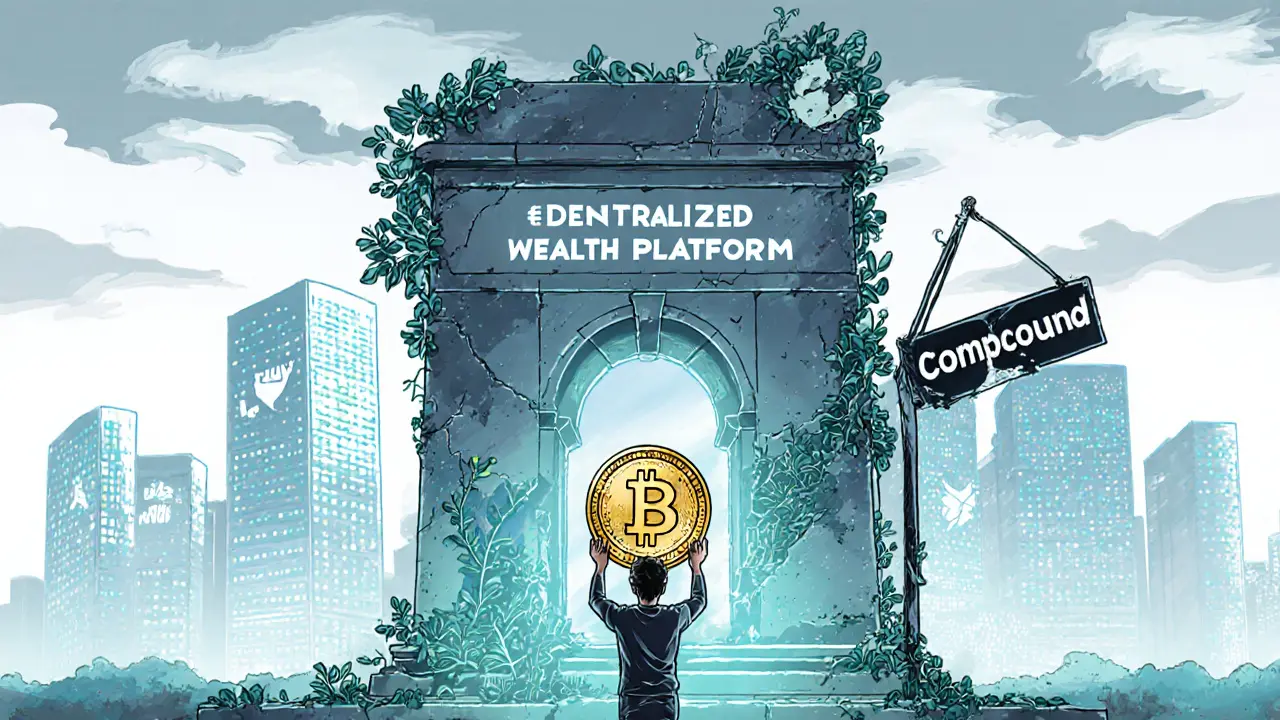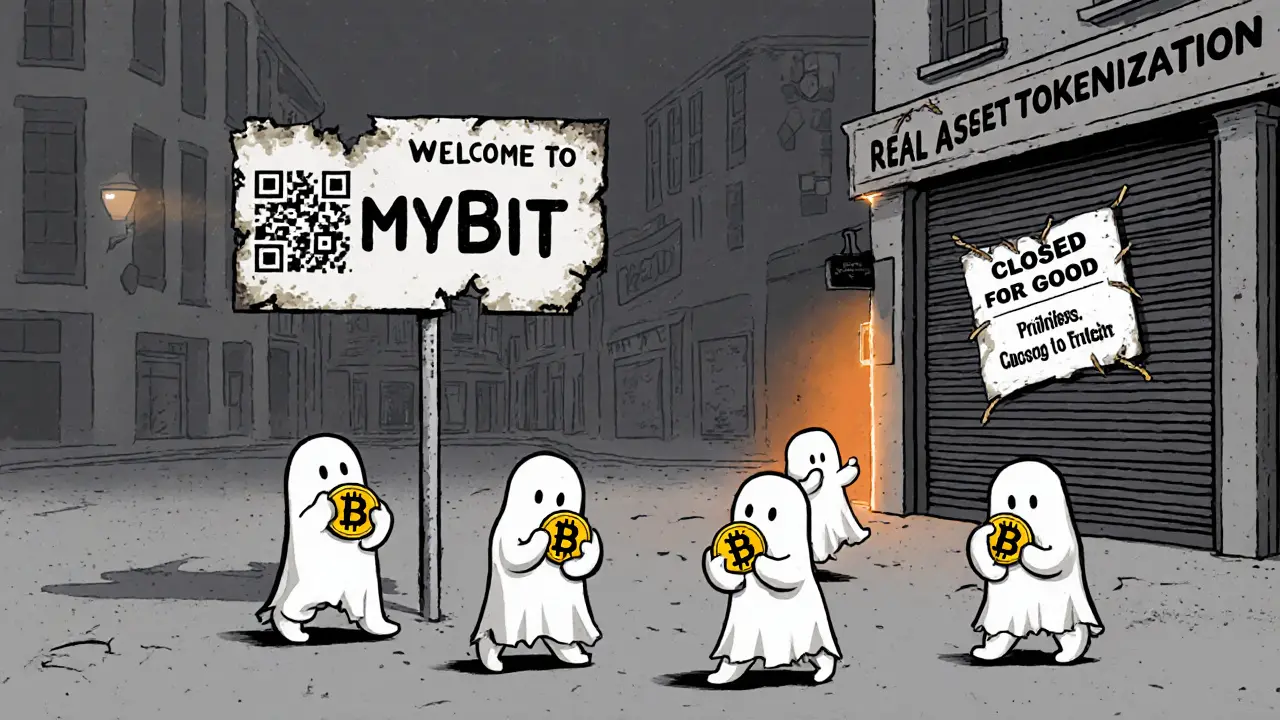MyBit Value Decay Calculator
Enter your initial investment at MyBit's peak (Jan 2018: $17.87) to see how much it's worth today ($0.00011). This tool demonstrates the dramatic value decay of abandoned crypto projects.
Value Decay Analysis
Note: This project has been inactive since 2018. No development, community, or use cases remain. This value decay demonstrates why most ICO-era projects failed.
MyBit (MYB) was supposed to be a tool that let anyone build decentralized apps for managing wealth - think of it like a digital toolkit for investing in real assets through blockchain. But today, it’s barely alive. If you’re wondering what MyBit is, the short answer is: it’s a cryptocurrency that once had big dreams, but now has almost no users, no updates, and almost no value.
What MyBit Was Designed to Do
MyBit launched in mid-2017, right in the middle of the crypto boom. Its goal was simple on paper: make it easy for regular people to invest in real-world assets - like solar panels, rental properties, or electric vehicle charging stations - by turning them into digital tokens you could buy and trade. The idea was to use Ethereum’s blockchain to cut out middlemen and let small investors get a slice of income-generating assets they’d never normally afford.
It wasn’t just another coin. MyBit claimed to be a platform where you could fund, track, and earn returns from real assets without needing a bank or broker. The token, MYB, was meant to be the fuel for this system - used to pay for services, vote on projects, and claim profits. The team behind it said it would let you ‘design, test, develop, and maintain decentralized wealth management applications on Ethereum.’ Sounds impressive, right?
What Happened to MyBit’s Value?
MyBit’s price peaked in January 2018 at around $17.87. That was the height of the crypto frenzy. People were buying anything with a whitepaper and a blockchain buzzword. But then the market crashed. And unlike Bitcoin or Ethereum, MyBit didn’t recover.
As of November 2025, MYB trades for about $0.00011. That’s a drop of more than 99.99% from its peak. To put that in perspective: if you bought $1,000 worth of MYB at its peak, you’d now have less than 11 cents. And it’s not just the price - trading volume is tiny. On most days, less than $50 worth of MYB changes hands. That’s less than what you’d spend on a coffee in New York.
Is MyBit Even Still Being Developed?
There’s no sign of active development. No blog posts. No GitHub commits. No team updates. No new features. The last real update from the MyBit team was back in 2018. The official website still exists, but it’s a static page with no news, no roadmap, and no contact info.
Compare that to projects like Compound or Aave - they keep releasing updates, adding new assets, improving security, and growing their user base. MyBit? Nothing. The token’s contract address on Ethereum - 0x5d60d8d7ef6d37e16ebabc324de3be57f135e0bc - hasn’t seen meaningful activity in years. No smart contract upgrades. No new partnerships. No integrations with DeFi protocols.

Where Can You Buy MyBit Today?
Very few exchanges list MYB. CoinLore says only one exchange still trades it. CoinMarketCap lists it, but with conflicting data - one report says 82 million tokens are in circulation, another says zero. That kind of inconsistency is a red flag. If even the data providers can’t agree on basic numbers, you know the project is dead in the water.
Even if you find an exchange that lists MYB, you’ll need an Ethereum wallet like MetaMask to hold it. You can add the token manually using its contract address, but there’s no official app, no wallet integration, no support. It’s like buying a key to a house that’s been abandoned for a decade - you can own it, but what’s the point?
How Many People Still Use MyBit?
According to CoinMarketCap, only about 1,830 wallets hold MYB. That’s fewer than the number of people who attend a small-town baseball game. There are no Reddit threads, no Twitter discussions, no Telegram groups with more than a few dozen members. No one is talking about it because no one is using it.
Compare that to a token like UNI, which has millions of holders and active communities. MyBit doesn’t even have a ghost town. It’s more like an empty lot with a broken sign still standing.

Why Did MyBit Fail?
It’s not just bad luck. MyBit failed because it never delivered on its promise. The idea was solid - tokenizing real assets is a real use case. But execution? Nonexistent. There’s no record of a single solar panel, rental property, or EV charger ever being funded through MyBit’s platform. No case studies. No user testimonials. No proof of real-world use.
Other projects in the same space - like RealT or Propy - actually built working platforms. They let people buy fractions of homes and earn rent. MyBit? Nothing. The team disappeared. The code stopped updating. The community vanished.
It’s a classic story from the 2017 ICO boom: hype, quick cash, then silence. Thousands of projects launched then. Most are gone. MyBit is one of them.
Should You Buy MyBit Today?
If you’re thinking about buying MYB, ask yourself: why?
It’s not an investment. It’s not a utility. It’s not a community. It’s a token with no ecosystem, no demand, and no future. The price is so low because no one wants it. Even if it bounced 10x tomorrow, you’d still be holding a digital ghost.
Some people buy these tokens hoping for a miracle rebound. But this isn’t Bitcoin in 2010. This is a dead project with no chance of revival. The market has moved on. The technology has evolved. MyBit didn’t.
What’s the Bottom Line?
MyBit (MYB) is a relic. It was a project that promised to change how people invest in real assets - but it never did. Today, it’s a footnote in crypto history. Its price is near zero. Its community is gone. Its team has vanished. Its code is frozen.
If you’re researching MYB out of curiosity, fine. But if you’re thinking of investing, don’t. You’re not buying into a project. You’re buying into a graveyard.
The real lesson here isn’t about MyBit. It’s about how easy it is to get fooled by a good pitch and a shiny whitepaper. In crypto, the most dangerous tokens aren’t the ones that crash. They’re the ones that pretend they’re still alive - when they’re not.

Write a comment